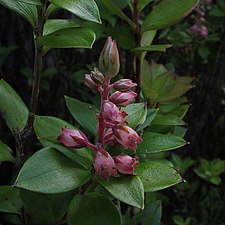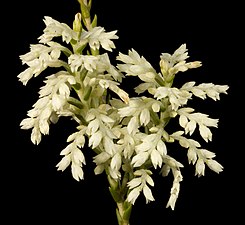Epacridoideae
| Epacridoideae | |
|---|---|

| |
| Epacris longiflora | |
| Scientific classification | |
| Kingdom: | Plantae |
| Clade: | Tracheophytes |
| Clade: | Angiosperms |
| Clade: | Eudicots |
| Clade: | Asterids |
| Order: | Ericales |
| Family: | Ericaceae |
| Subfamily: | Epacridoideae Arn. |
| Tribes and genera | |
| Synonyms | |
| |
Epacridoideae is a subfamily of the family Ericaceae. The name Styphelioideae Sweet is also used. The subfamily contains around 35 genera and 545 species. Many species are found in Australasia, others occurring northwards through the Pacific to Southeast Asia, with a small number in South America.[1]
Description
The Epacridoideae form a well supported monophyletic group within the family Ericaceae, clearly diagnosable using a combination of morphological characters. These include a lignified leaf epidermis, dry, membrane-like (scarious) bracts on the inflorescence, and a persistent corolla. The stamens are also distinctive: there are fewer than twice the number of corolla lobes and their filaments are smooth. Some of these characters are individually present in other members of the family Ericaceae. Core members of the subfamily (i.e. excluding Prionoteae) also have parallel- or somewhat palmate-veined leaves and lack multicellular hairs.[2]
Taxonomy
In 1810, Robert Brown treated the group as the family Epacridaceae.[3] It was treated as a subfamily by Robert Sweet in 1828 (using the name Stypheliae).[4] George Arnott Walker-Arnott also treated it as a subfamily in 1832 (using the name Epacrideae).[3] Although Sweet's name is earlier, Article 19.5 of the International Code of Nomenclature for algae, fungi, and plants provides that when a subfamily is formed by reducing the rank of a family, the type of a conserved family name has precedence, making Epacridoideae the correct name.[5][6][7] Although Sweet and Walker-Arnott had treated the group as a subfamily, botanists preferred Brown's rank of family, as in the Cronquist system, until both morphological and molecular phylogenetic studies in the 1990s showed that excluding Epacridaceae from Ericaceae made the latter paraphyletic.[2]
Phylogeny
The subfamily is divided into tribes, whose suggested relationship is shown in the following cladogram. The number of genera is approximate.[1]
| |||||||||||||||||||||||||||||||||||||
Genera
Based largely on the phylogenetic classification of Kron et al. (2002),[2] with some later modifications,[8][9][10] genera that may be placed in the subfamily include the following (tribe in parentheses):
- Acrothamnus Quinn (Styphelieae)
- Acrotriche R.Br. (Styphelieae)
- Agiortia Quinn (Styphelieae)
- Andersonia R.Br. (Cosmelieae)
- Androstoma Hook.f. (Styphelieae)
- Archeria Hook.f. (Archerieae)
- Astroloma R.Br. (Styphelieae)
- Brachyloma Sond. (Styphelieae)
- Coleanthera Stschegl. (Styphelieae)
- Conostephium Benth. (Styphelieae)
- Cosmelia R.Br. (Cosmelieae)
- Croninia J.M.Powell (Styphelieae)
- Cyathodes Labill. (Styphelieae)
- Cyathopsis Brongn. & Gris (Styphelieae)
- Decatoca F.Muell. (Styphelieae)
- Dielsiodoxa Albr. (Oligarrheneae)
- Dracophyllum Labill. (Richeeae)
- Epacris Cav. (Epacrideae)
- Lebetanthus Endl. (Prionoteae)
- Leptecophylla C.M.Weiller (Styphelieae)
- Leucopogon R.Br. (Styphelieae)
- Lissanthe R.Br. (Styphelieae)
- Lysinema R.Br. (Epacrideae)
- Melichrus R.Br. (Styphelieae)
- Monotoca R.Br. (Styphelieae)
- Montitega C.M.Weiller (Styphelieae)
- Needhamiella L.Watson (Oligarrheneae)
- Oligarrhena R.Br. (Oligarrheneae)
- Pentachondra R.Br. (Styphelieae)
- Planocarpa C.M.Weiller (Styphelieae)
- Prionotes R.Br. (Prionoteae)
- Richea R.Br. (Richeeae)
- Sphenotoma (R.Br.) Sweet (Richeeae)
- Sprengelia Sm. (Cosmelieae)
- Styphelia Sm. (Styphelieae)
- Trochocarpa R.Br. (Styphelieae)
- Woollsia F.Muell. (Epacrideae)
- Archeria racemosa (Archerieae)
- Cosmelia rubra (Cosmelieae)
- Lysinema ciliatum (Epacrideae)
- Oligarrhena micrantha (Oligarrheneae)
- Prionotes cerinthoides (Prionoteae)
- Richea dracophylla (Richeeae)
- Styphelia tubiflora (Styphelieae)
Distribution
Members of the Epacridoideae are largely confined to Australasia, being particularly diverse in southwestern Western Australia, Tasmania, and southeastern Australia. However, some species occur in southern South America (Lebetanthus), Hawaii (Styphelia), and Southeast Asia (Leucopogon).[2]
References
- ^ a b Stevens, P.F. (2001 onwards), "Ericales: Epacridoideae", Angiosperm Phylogeny Website, retrieved 2022-10-21
- ^ a b c d Kron, K.A.; Judd, W.S.; Stevens, P.F.; Crayn, D.M.; Anderberg, A.A.; Gadek, P.A.; Quinn, C.J. & Luteyn, J.L. (2002), "Phylogenetic Classification of Ericaceae: Molecular and Morphological Evidence", Botanical Review, 68 (3): 335–423, doi:10.1663/0006-8101(2002)068[0335:PCOEMA]2.0.CO;2, JSTOR 4354425, S2CID 35699816
- ^ a b Reveal, James L. (2011), "Indices Nominum Supragenericorum Plantarum Vascularium – E", Indices Nominum Supragenericorum Plantarum Vascularium, retrieved 2022-10-21
- ^ Reveal, James L. (2011), "Indices Nominum Supragenericorum Plantarum Vascularium – S", Indices Nominum Supragenericorum Plantarum Vascularium, retrieved 2022-10-21
- ^ Crayn, Darren M.; Kron, Kathleen A. & Potter, Benjamin C.M. (2014), "Typification of some names in Epacridoideae (Ericaceae)", Telopea, Journal of Plant Systematics, 17: 319–321, doi:10.7751/telopea20147924, p. 320
- ^ Turland, N.J.; et al., eds. (2018), Article 19. International Code of Nomenclature for algae, fungi, and plants (Shenzhen Code) adopted by the Nineteenth International Botanical Congress Shenzhen, China, July 2017 (electronic ed.), Glashütten: International Association for Plant Taxonomy, retrieved 2022-10-21
- ^ McNeill, John & Turland, Nicholas (2005), "Synopsis of Proposals on Botanical Nomenclature - Vienna 2005. A Review of the Proposals concerning the International Code of Botanical Nomenclature Submitted to the XVII International Botanical Congress", Taxon, 54 (1): 215–250, doi:10.2307/25065335, JSTOR 25065335, pp. 224–225
- ^ Crayn, Darren M.; Brown, Elizabeth A. & Powell, Jocelyn M. (2003), "A revision of Lissanthe (Styphelioideae: Ericaceae)", Australian Systematic Botany, 16 (5): 600, doi:10.1071/SB03014
- ^ Quinn, Christopher J.; Brown, Elizabeth A.; Heslewood, Margaret M. & Crayn, Darren M. (2005), "Generic concepts in Styphelieae (Ericaceae): the Cyathodes group", Australian Systematic Botany, 18 (5): 439–454, doi:10.1071/SB05005
- ^ Albrecht, D.E.; Owens, C. T.; Weiller, C. M.; Quinn, C. J. (2010), "Generic concepts in Ericaceae: Styphelioideae: the Monotoca group", Australian Systematic Botany, 23 (5): 320–332, doi:10.1071/SB10009







